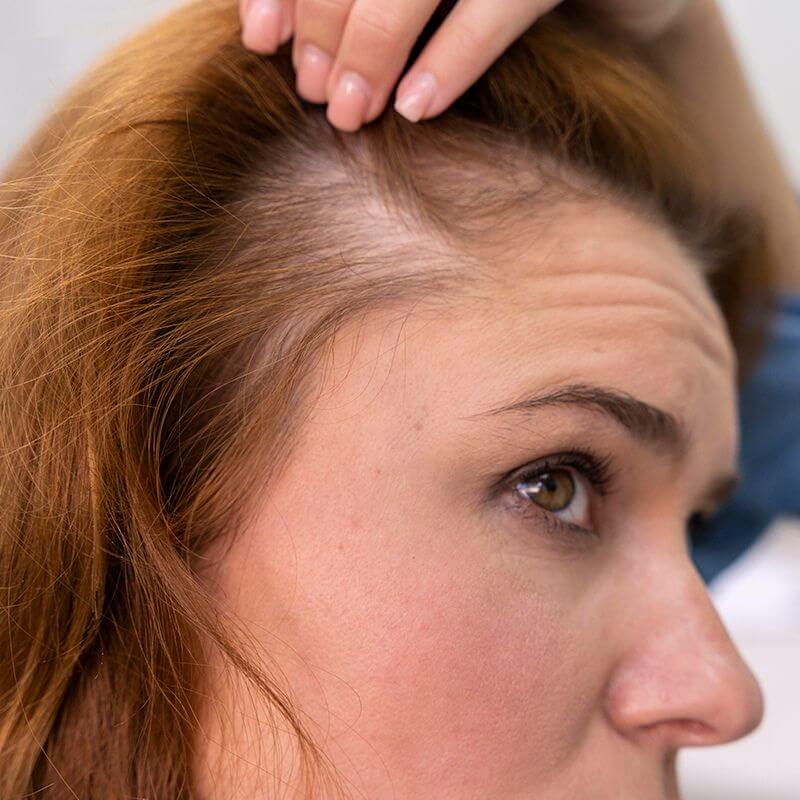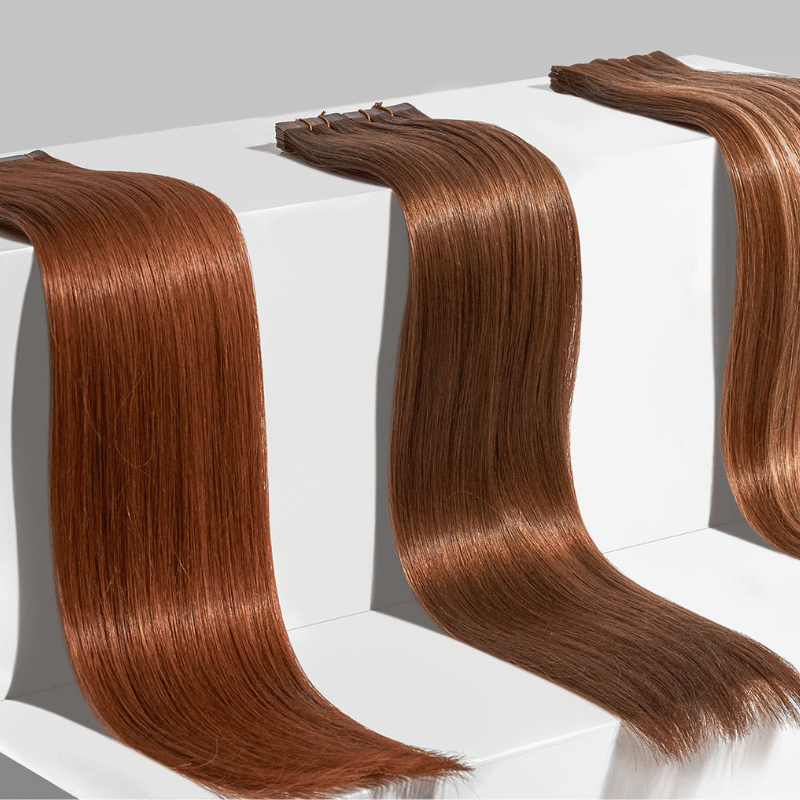
Hormonal Hair Loss in Women : A Guide For Hair Professionals
Did you know that 95% of all female hair loss is caused by hormonal changes? This is often referred to as androgenetic hair loss, amongst professionals.
We know that, in your salon, you meet a variety of clients with vast hair needs. But do you know how to recognise the signs and support your clients with hormonal hair loss?
At North, we strive to educate stylists, like yourself, on how to provide the best hair outcomes for your clients. In this article, you will learn about the different types of hormonal hair loss, how to spot the signs, and how best to support your clients.
What is hormonal hair loss and what causes it?
Other than keeping up with the latest trends, you need a strong knowledge of hair and scalp health. Hormonal hair loss is something you will commonly see in your salon, but do you know what it is and what causes it?
Hormonal hair loss is a broad term that describes any type of hair loss caused or triggered by hormonal changes. However, the specific causes depend on what type of hair loss your client may be suffering with.
According to research found by Felix, hormonal imbalances resulting in hair loss typically have to do with a drop in oestrogen and progesterone and a rise in androgens, such as testosterone. These androgens can shrink your hair follicles, resulting in hair loss.
What are the types of hormonal hair loss?
Educating yourself on the different types of hormonal hair loss will not only develop your knowledge, but will also help you to support your clients. Your customers trust your expertise, so keep it top-notch!
So, what are the different types? As reported by The Institute of Trichologists, these are the six most common hormone-related causes of hair loss that they often see:
Androgenetic (Female Pattern) Hair Loss
Androgenetic or Female Pattern Hair Loss is a genetic condition - an inherited sensitivity to a hormone, created by the conversion of testosterone into a more potent variant, dihydrotestosterone (DHT).
DHT affects hair throughout its growth cycle, resulting in the hair gradually getting thinner and eventually stopping growing. In women, this type of hormonal hair loss produces a diffuse thinning - a wide parting and more visible scalp.
Hypothyroidism and Hyperthyroidism and hair loss
Both thyroid disorders are caused by an imbalance of hormones. Severe and prolonged cases of both conditions can cause hair loss, presenting as diffuse thinning across the scalp. Regrowth can occur with successful treatment of the thyroid disorder, however, some people tend to incorrectly blame thyroid medication for hair loss.
Stress-induced hair loss
Stress is often blamed for hair loss, and with good reason! Stress releases hormones like adrenaline, cortisol and testosterone, which can suppress oestrogen and result in hormonal hair loss.
Puberty-related hair loss
Puberty is a period in our lives when hormones take a huge effect on our bodies. There is often a sudden influx of dihydrotestosterone (DHT), which may result in diffuse hair loss for females. However, puberty-related hair loss isn’t common.
Pregnancy and postpartum hair loss
Pregnancy and childbirth are huge hormonal changes in a woman’s body. Women produce more oestrogen during pregnancy, resulting in the hair staying in its growth phase for longer, with less hair shedding and a noticeably thicker head of hair.
Postpartum (3-6 months after giving birth), hormones stabilise and the normal hair cycle returns. This often results in much greater hair shedding than normal. This can be alarming, but once the hormone levels out again, hair growth does return.
Menopausal hair loss
Menopause is another example of hormonal change. Menopausal hair loss is related to the reduction of oestrogen and progesterone which allows androgens, such as testosterone, to dominate. Hair begins to grow more slowly and becomes thinner and more susceptible to breakage.
Is hormonal hair loss preventable?
Do you have clients worried about hormonal hair loss and asking for ways to prevent it?
Hormonal hair loss is generally not preventable, but that doesn’t mean that it will happen to everyone. Unfortunately, we cannot change androgenetics or our bodies’ reactions to hormonal changes.
Menopause-related hair loss can be prevented if detected early. Your client would need to starts hormone replacement therapy (HRT), to boost oestrogen and progesterone levels, before hair loss occurs.
Stress-related hair loss can also be prevented, though easier said than done. Talking therapies, exercise, good sleep hygiene and diet can reduce stress, without the need for medications that could further impact hair loss.
Is hormonal hair loss reversible?
Do you have clients worried that their hormonal hair loss is permanent? Hair can have a large impact on our customers’ self-esteem and it is often your job to reassure them.
Most cases of hair loss caused by hormonal changes or imbalances are reversible. Once hormones begin to balance, hair loss symptoms should start to slow and cease. In many cases, hair loss should also be replaced with new growth.
Depending on the cause of the hormonal hair loss, it may just take time for the hormone levels to balance. Some women may need to go on medications, such as HRT. Lifestyle changes can also help balance your levels, such as sleep, diet and exercise.
What are the signs of hormonal hair loss?
What signs should you be looking out for in your salon?
According to the Mayo Clinic, these are the top three signs of hormonal hair loss:
Gradual thinning on top of the head
This is the most common sign of hair loss. Women typically have a broadening of the part in their hair. However, an increasingly common hair loss pattern in older women is a receding hairline.
Circular or patching bald spots
Some women lose their hair in circular or patchy bald spots on their heads.
Sudden loosening of hair
This sign is more associated with stress-induced hormonal hair loss, resulting in handfuls of hair coming out when brushing or washing.
How to help clients with hormonal hair loss
Paloma has a great article on how to talk about hair loss in your salon. We have built on their points to share these crucial steps with you:
Know the signs
Knowing how to look out for the signs of hormonal hair loss will make you better at your job - it’s as simple as that. It’s also important to educate your clients on how to spot the signs, so that everyone knows what to be looking for.
Read the above to solidify your understanding.
Know the causes
Knowing what causes hormonal hair loss will make you stand out as a hairdresser - the more you know, the more you can help!
If your client is suffering from hair loss, talk to them about what is going on in their life. You may be able to spot the cause before they do! However, remember that you’re a hair genius - not a doctor.
Again, read above to solidify your understanding.
Create a safe place
Your salon should be a safe place for anyone who walks through your doors and your relationship with your clients should be built on trust and understanding.
Let your clients know they can talk to you about anything, especially their hair concerns. Your clients may feel embarrassed or ashamed, so make sure to ask the right questions to get them to open up to you.
Take time with your client to demonstrate empathy and compassion, without jumping to solutions. Listen actively and never push your client to talk more than they want to - take everything at their pace.
Work on the solutions together
If your client doesn’t know what is causing their hair loss, your first solution suggestion should be to seek medical advice.
Once both you and your client have a cause pinpointed, you can then work on solutions that either you can do for them in the salon and/or they can do at home.
Read below to find the advice that we would give.
What can your clients do to help their hair loss?
Wondering what advice you can give, so that your clients can treat their hormonal hair loss at home?
Healthy habits
Women’s Health wrote a great article on hormonal hair loss treatments. The article recommends ‘ample exercise, meditation, and healthy habits’ as the best treatments for hormonal hair loss - backed by Cleveland Clinic dermatologist, Melissa Piliang M.D. It also recommends vitamins and supplements to support hair growth, post-shedding.
Head massages
Head massages are another way to promote hair growth. Head massages can reduce stress and stimulate blood flow across the scalp. Brushing the scalp every night can also stimulate blood circulation - recommended with a soft bristle brush.
Using the right products
At-home thickening treatments can also support hair growth in between salon visits. Brands offer different treatments available in the salon or at home, so be sure to recommend products that you would use.
You should also recommend other hair care products that are going to benefit your client’s hair type. Look for volumizing shampoos and conditioners formulated for fine hair - not deep conditioning shampoos or treatments, which will weigh the hair down.
If your client suffers from hair loss patches, why not recommend colour sprays? These can add the illusion of density and fullness to the hair in an instant.
Styling tricks
The way you style a client's hair can dramatically change how it looks with hormonal hair loss. Volumizing mousse and lightweight hairspray can be a simple way to disguise hair loss, which your clients can do at home too!
Lo’real recommends applying a volumising mousse to wet hair after washing, then drying the hair upside down - giving volume and movement to the root. Once the hair is almost dry, continue to style upright and use a lightweight hairspray that won’t weigh the hair down.
Hair supplements
Our resident hairdresser, Charlotte Quinn, promotes Glowwa Hair Food to her clients - a ‘natural, vegan and planet friendly hair supplement’, found to benefit hair growth, reduce shedding, improve condition, increase shine and more.
Glowwa has also just come out with a range specific to menopausal women, Meno, which has natural DHT blockers and promotes various well-being benefits, not just for hormonal hair loss.
Accessories
One way clients can disguise their hair loss is by playing around with accessories. Hats, scarves, bands and clips can hide unwanted patches and disguise them into a stylish look.
Clip-in extensions
Clip-in extensions are a quick and easy way to disguise hormonal hair loss. With correct application, clip-in extensions can blend seamlessly into the natural hair, adding length and volume.
Stranded Hair stock of a variety of different clip-in extensions, such as curly one piece, straight ponytail and super easy mum bun.
What solutions can you provide in the salon for hormonal hair loss?
We’ve already discussed head massages, products and styling tips that can be provided in the salon, as well as at home. But what else?
One of the best ways you can support your clients with hormonal hair loss, in the salon, is by providing strategies on how to disguise it.
Haircut
An easy way you can help your clients disguise their hair loss is through a good cut. Advise your clients on haircuts that create the illusion of thickness and volume - shorter hair often looks fuller.
Hair colour
Hairdressers can use colour to give movement and dimension to the hair, alluding to thickness. Advise your clients on multidimensional colours and different placements of natural highlights and lowlights, such as the balayage technique.
Styling
We touched on styling earlier, but changing your client’s hair parting is another great way to disguise sparsity and patching. Moving partings to the side can also add volume to the hair.
Make sure to cut and style a change in parting, to make it look more natural.
Extensions
Is your client in a position to commit to professional hair extensions? Extensions are a great way to disguise hormonal hair loss - making it look longer, fuller and more voluminous.
Tape extensions, such as those by North, are one of the best and safest professional extension methods for thinner hair. The versatility of tapes make them ideal for client hair loss, your client can keep costs down, by starting small with 40g of hair and use them as fillers around areas of concern. Invisible tapes can make this disguise truly indistinguishable.
What next?
You came across this article because you wanted to learn more about hormonal hair loss and how to support your clients who suffer from it.
Throughout, you have learned about the causes, how to spot the signs and various ways to help your clients both in the salon and at home. But what next?
At North, we know that informed and educated stylists are the best in business - that’s why we make content like this!
This article should lay the foundation of your hair loss knowledge, but there is always more to learn. We would recommend checking out Felix Health for more hair loss informational content.
If you would like to learn more about how tape extensions can support clients with hormonal hair loss, call our customer service team at 0161 791 2726. More information on our tape extensions and Habia Approved Training can be found on our website.


